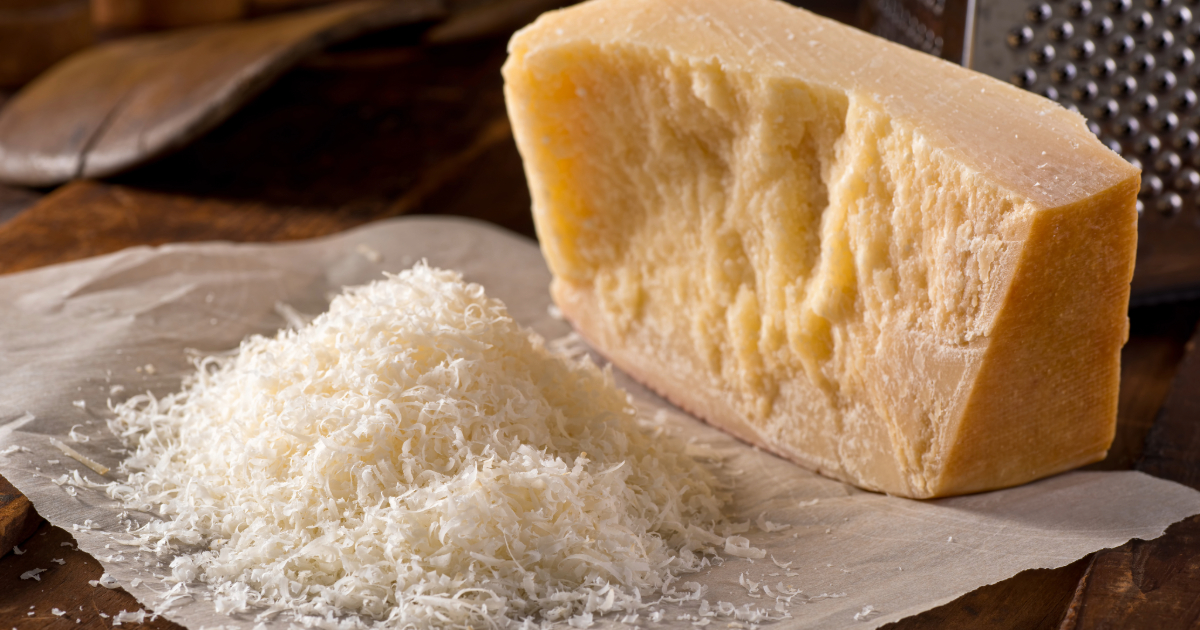Parmesan and Parmigiano Reggiano can seem like the same Italian cheese. After all, they have similar spellings and appearances. But looks can be deceiving. While they share some common ground, they are very different products in reality.

So what exactly sets Parmesan and Parmigiano Reggiano apart? Where does each one come from, how is it made, and what does it taste like?
Origin and Legal Definitions
The first major difference between Parmesan and Parmigiano Reggiano lies in their origins and legal designations.
Parmigiano Reggiano hails specifically from the Emilia-Romagna region of Italy. This area includes the Italian provinces of Parma, Reggio Emilia, Modena, Bologna, and sections of Mantua.
By law, to be called Parmigiano Reggiano, the cheese must be made in one of these authorized zones. The name also tells you where it’s from—“Parma” and “Reggio” refer to the key cities of Parma and Reggio Emilia.
Parmigiano Reggiano is also a Protected Designation of Origin (PDO) product in the European Union. This strict status means it must be made totally within its native region using traditional methods.
Parmesan, on the other hand, is not a protected name. It can technically be made anywhere in the world. Most Parmesan you find outside Italy does not have PDO status.
Therefore, inside the EU, “Parmesan” actually refers to the same cheese as Parmigiano Reggiano. But elsewhere, it’s an open-ended term applied to similar cheeses inspired by the original.
| Cheese | Legal Protection | Place of Origin |
|---|---|---|
| Parmigiano Reggiano | Protected (PDO) | Emilia-Romagna, Italy only |
| Parmesan | Unprotected | Can be made anywhere |
So if you’re in Europe, Parmesan must equal Parmigiano Reggiano. But in America, “Parmesan” on a label won’t guarantee authenticity. Names aside, read on to see how making methods also differ.
Key Takeaway: Real Parmigiano Reggiano only comes from certain provinces in Emilia-Romagna, Italy.
Ingredients and Production Methods
The processes for crafting Parmigiano Reggiano and Parmesan start out alike. But strict rules guide one, while the other allows more creativity.
Both cheeses begin by heating cow’s milk to remove cream and develop curds. The curds then drain and form solids that get molded, pressed, salted, and ripened into wheels.
However, Parmigiano Reggiano answering to its PDO makes the grade by:
- Using only raw or partially skimmed cow’s milk
- Adding only salt and calf rennet for coagulation
- Ensuring the cattle eat a traditional diet of local hay and forage
- Aging wheels for at least 12 months up to 3+ years
This ensures a consistent, high quality product each time.
Parmesan outside Italy lacks these bounds:
- Can use pasteurized milk, additives, preservatives
- Allows rennet substitutes and artificial colorings
- No diet regulations for the dairy cows
- Aging time as little as 10 months (no minimum)
Without production safeguards, Parmesan variations are endless. Familiar brands like Kraft use extra ingredients for easier processing and shelf life. So flavor and texture vary wildly from Parmigiano Reggiano’s reliability.
Key Takeaway: Real Parmigiano Reggiano follows rigid rules for ingredients and methods passed down for centuries in Italy. Parmesan does not.
Taste and Texture
Thanks to meticulous crafting, each Parmigiano Reggiano wheel delivers complexity with:
- Rich, nutty flavors that grow sharper and intensify over longer aging
- Slightly gritty, crumbly texture with tangible salt crystals
- Noticeable umami flavor from amino acids
With less molding, authentic Parmigiano Reggiano offers an unmatched punchy profile fine restaurants crave.
As an imitation, Parmesan lacks consistency by nature:
- Can seem blander, saltier, or bitter next to the original
- Often has a smoother, gummier mouthfeel vs. Parmigiano Reggiano’s crunch
- Cheaper versions use fillers like cellulose to seem less processed
Still, some small-scale artisanal Parmesan delivers fine eating that echoes Italy’s gold standard. But it’s still not the real thing.
Price and Accessibility
Thanks to farmer oversight and years of aging, Parmigiano Reggiano costs more than knock-offs. But better flavor and nutrition merit the investment.
Seeking authenticity, buy Parmigiano Reggiano by:
- Checking rinds for PDO stamps reading “Parmigiano Reggiano” in pin dot patterns
- Finding retail chunks with Consortium logos to confirm properly vetted wheels
- Using grated packages clearly labeled as protected Parmigiano Reggiano
For more affordable, everyday use, Parmesan offers a fine substitute:
- Many major brands provide consistent quality for cooking in volume
- Seek domestic specialty producers focused on artisanal Italian technique
- Avoid pre-grated Parmesan with anti-caking fillers diluting flavor
Either way, buying whole chunks instead of shreds gives fresher, purer cheese to last.
Key Takeaway: Authentic Parmigiano Reggiano costs more due to labor and aging, but offers bolder flavor and stricter standards versus Parmesan.
FAQs
What’s the difference between Parmigiano Reggiano and other hard Italian cheeses?
Parmigiano Reggiano differs from relatives like Grana Padano or Pecorino Romano through its exclusive production zone, use of partially skimmed cow’s milk, and over one year minimum aging time.
Is locally made Parmesan just as good?
Quality Parmigianos produced outside Italy can compete well when using traditional ingredients and techniques. But they lack the legacy and assurances tied to real Parmigiano Reggiano’s protected status.
Why does Parmigiano Reggiano cost more than Parmesan?
The labor-intensive production of Parmigiano Reggiano requires additional time, restrictions, and monitoring to warrant its protected heritage. This gets passed to consumers through higher prices.
Can I use Parmesan when a recipe calls for Parmigiano Reggiano?
Feel free to substitute Parmesan in most recipes, especially baked dishes, pastas, and sauces. But for refined finishing uses where cheese takes center stage, spring for Parmigiano Reggiano to appreciate its renowned nuance.
Conclusion
While their labels look close, Parmigiano Reggiano and Parmesan actually describe very different products.
Strict rules governing ingredients, processes, and aging set Italian Parmigiano Reggiano apart as a cheese completely unique to its native region.
Parmesan offers similar flavor at more budget-friendly prices. But without Production Designation ties to Italy, quality control varies widely.

